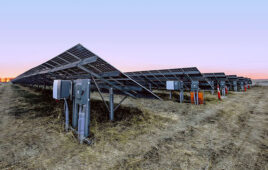
Jim Petersen, President and CEO, PetersenDean Roofing & Solar
By Jim Petersen, President and CEO, PetersenDean Roofing & Solar
Who would ever think that a common and ubiquitous product–the storage battery, which dates to the 1880s–could become a new backbone for the future of our nation’s electric power and renewable energy industries? But with advanced digital technology, new storage options and supportive partnerships, I believe the prospects for storage battery technology get brighter every day. We are indeed at the start of a new generation of energy, and hopefully we will continue down the road.
The new energy paradigm
Storage technology is bringing our country to the forefront of a new energy paradigm that is gaining significant attention as a way to supplement the electric utility grid, advance use of solar power and protect our environment.
I believe this new energy paradigm is a win-win for solar energy users as well as for utilities and energy consumers. By investing in solar power coupled with energy storage and management systems, businesses and homeowners can help support the conservation efforts of utilities to reduce the impact of energy disruptions such as black and brown outs.
On a national scale, the U.S. storage industry includes hundreds of companies and thousands of American workers building and installing energy storage systems with substantial growth on the horizon.
The market research firm IHS Markit projects that the energy storage market is set to expand from an initial base of only 0.34 GW installed in 2012 and 2013, to an annual installation size of 6 GW in 2017, and more than 40 GW by 2022. An IMS Research report expects the market for storing power from solar panels–which was less than $200 million in 2012–will catapult to $19 billion this year. On the East Coast, more than 60 million Americans in 13 mid-Atlantic states and the District of Columbia are saving money and receiving high quality service thanks to energy storage systems operating in that region.

New partnerships
This is the time for companies and researchers involved in advancing solar energy and solar battery technologies to form partnerships and provide funding to ensure the research continues.
For example partnerships between solar energy providers and water districts could save water customers millions of dollars. A retired dairy farm in Southern California was transformed into a 1.5-MW solar power system for the Phelan Piñon Hills Community Services District. This solar system now produces enough energy to offset 40% of the district’s water-producing electricity costs and expects to save $13 million over 30 years, not to mention the positive environmental impact. California’s Public Utilities Commission also approved a target requiring its three largest investor-owned utilities, aggregators and other energy service providers to procure 1.3 GW of energy storage by 2020. In response, Southern California Edison partnered with Canada-based AltaGas to build a 20-MW storage project with a power capacity of 80 MWH at the utility’s Pomona Facility in the East Los Angeles Basin of Southern California. San Diego Gas & Electric also announced a partnership with AES Corp. to construct two energy storage arrays, totaling 37.5 MW of storage projects on utility-owned property in Escondido and El Cajon.
We’ve also recently partnered with LG Chem and SolarEdge to offer solar battery technology as part of a solar system package for residential customers. We believe partnerships such as these are the tip of the proverbial iceberg.

The benefits of storage
We in the solar and storage industries must collaborate at the highest level to keep the momentum moving. The energy storage market is being driven by improved energy efficiency, the declining cost of solar equipment and higher capacity energy storage that is made possible by improved battery technology. This creates a huge benefit for consumers of electric power.
In the solar sector, the rapidly growing residential battery marketplace is making its mark. By combining solar and batteries with smart software, a home energy management system can analyze the occupant’s historical energy consumption trends to develop efficiency recommendations that include the exact combination of stored and renewable energy required to power a home and also limit energy demand.
This makes it possible for solar power users to utilize stored solar energy during peak times when utility rates are at their highest, resulting in lower bills, or financial gain by selling their excess energy back to the grid. In light of all the changes imposed by utilities and regulatory agencies, this storage technology provides consumers more choices and control in their efforts to save money and to help our environment by using more renewable energy.
Going a step further, electric utilities such as SCE and SDGE understand the value of storage battery technology for creating a smarter grid that, among other benefits, can give utilities better control over managing peak demand to improve system reliability and reduce the cost of electricity to their customers.
Effective energy policies, economies of scale and new technologies have achieved something remarkable: solar energy production and battery storage are now at the scale and cost necessary so that it is a big piece of the energy puzzle. Solar energy and batteries are becoming part of the mainstream. Families, schools and businesses are going solar in record numbers nationwide, even as incentives decrease. Now that we’ve built this new energy economy, it’s critical that we keep the way clear for Americans to keep going solar and storing that solar.





Tell Us What You Think!